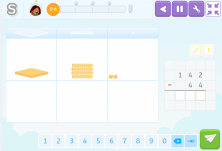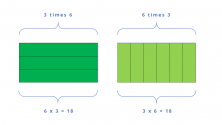Dyscalculia, the Great Unknown
In an earlier post, we spoke about a very current but not very well known topic: dyscalculia. Dyscalculia can present itself in a very diversified way but, generally, children that suffer from this specific learning disorder have difficulties with the basic aspects of numerical processing and calculation. These difficulties, if not treated at a basic level, will negatively influence the development of more advanced mathematical abilities. In order to support the learning of math concepts in children with dyscalculia, we should keep in mind the typical characteristics of these students and provide them with the tools they need.
The Importance of Learning Concrete and Abstract
Normally, children with dyscalculia have problems memorizing numbers and basic numerical information. In other words, for these children it is especially necessary that learning is based on a deep understanding of the concepts and procedures. So, for example, procedures to solve basic operations should be explained and practiced instead of merely memorized.
To facilitate a deep understanding of concepts and mathematical reasoning, learning should move from concrete to abstract concepts. For example, in teaching the positional value of numbers we can begin with an explanation of the concept with real objects, like rulers, continue the representation in the form of a drawing and finally by only using abstract symbols (digits). In this process, manipulative materials, like those used in Smartick, play a very important role.
A Fundamental Tool: Manipulative Materials
Manipulative materials help children process learning by stimulating the internalization of the mathematic concepts through the transition from concrete experience to abstract reasoning. Scientific studies show that the use of manipulative materials is particularly important for children with learning difficulties (Ruzic and O’Connell, 2001). The emphasis should always be on a deep understanding of concepts, never on the use of materials to find answers mechanically. We are going to look at some examples that can be found in Smartick.
- Base 10 blocks are an effective tool to support the understanding of calculation procedures such as subtraction with borrowing. Being able to visually represent the numbers used in the calculation and apply the procedure to objects, serves to support a deep understanding of procedures instead of just memorizing them.

- Manipulative materials can also be used in problem-solving. In fact, the ability to visually represent a problem is indicative of comprehension, and therefore performance is better with this type of tasks.

- Another difficult concept to internalize for children with dyscalculia is multiplication. In this case, Cuisenaire rods can help by allowing concepts, like a repeated addition or the commutative property, to be represented visually.

A common error when using manipulative materials is only using them to demonstrate a concept without allowing the students to be able to manipulate the materials themselves. Children have to be free to explore the materials, experience trial and error, and learn through practical experience and mistakes.
References:
- Ruzic, R., & O’Connell, K. (2001). Manipulatives. Enhancement Literature Review.
Learn More:
- Dyscalculia: What It Is, Causes and Treatments
- Digital Manipulative Materials Used by the Smartick Method
- Foundations of the Singapore Method in Math Instruction
- Cognitive Training and Its Application to Improve Dyscalculia Symptoms
- Is It Good to ¨Mix¨ Alternative Algorithms, Such as ABN, with Traditional Ones?
- Mistakes: An Opportunity to Learn - 05/07/2020
- The Importance of Positive Reinforcement in Education - 04/02/2020
- Is It True That Boys Are Better at Math Than Girls? - 03/05/2020







